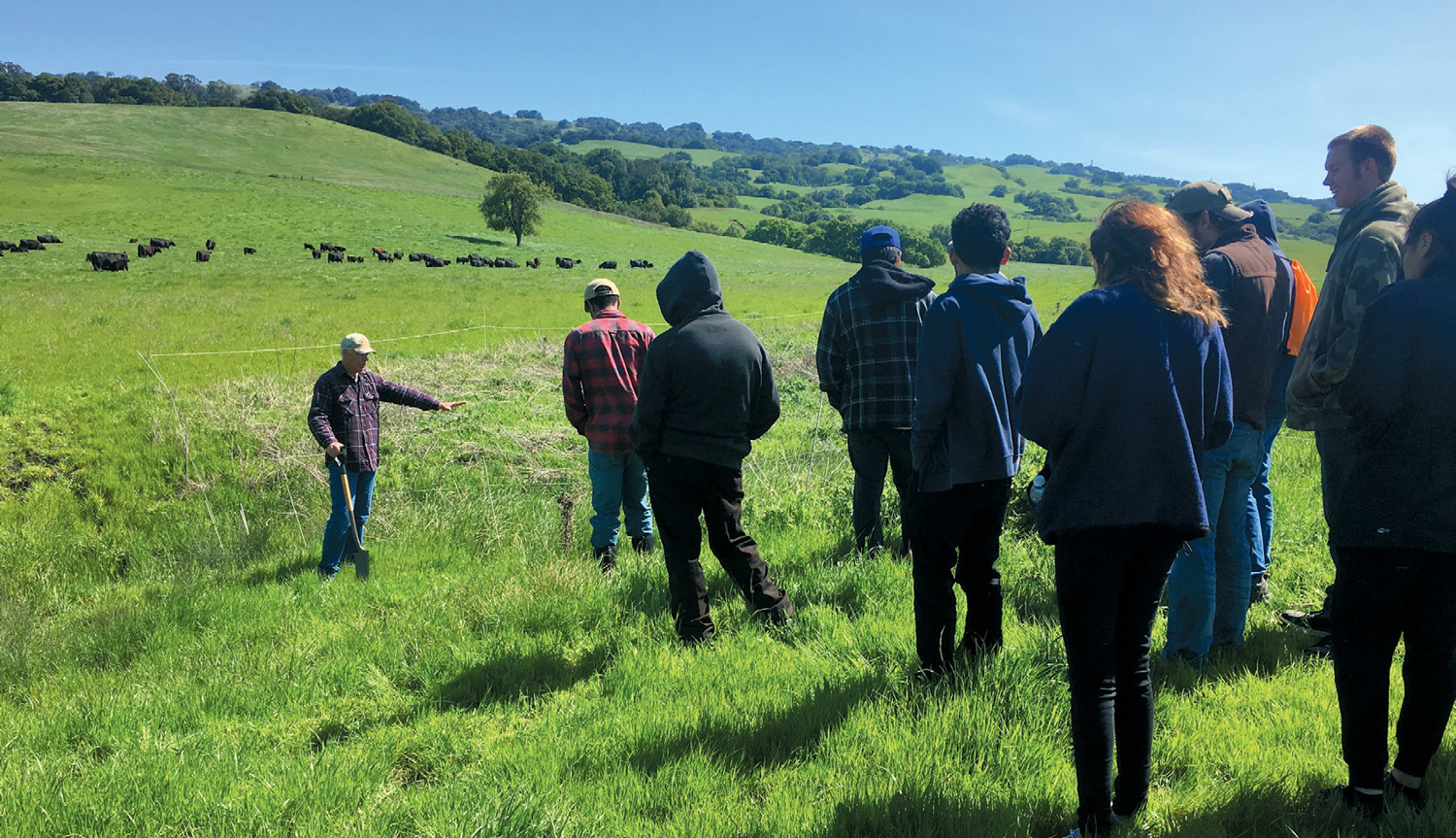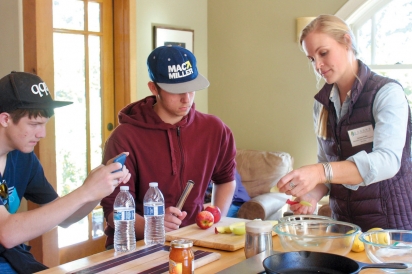Sonoma County's Farms Leadership Program
TEACHING LIFE SKILLS, ALONGSIDE HOW TO TEND VINES AND VEGETABLE GARDENS
It is early on a Thursday morning and, like on every other schoolday morning, teenagers are pulling up in front of the classroom. Carpools of bleary-eyed boys and girls emerge into the cold morning air, lanky limbs clad in jeans and flannel shirts. They stretch and shake off sleep, looking around nonchalantly as they get ready to begin the school day.
Only this isn’t your normal classroom. Today, the students are being “schooled” at the Scott Ranch, tucked high in the hills east of Petaluma. The teacher who leads this band of teenagers into the barn, where they sit down on hay bales arranged in a semi-circle, is local rangeland specialist Richard King. The students are from Analy, Laguna, Carpe Diem, Sonoma Mountain, Pivot Charter School North Bay and Windsor Oaks Academy high schools and have been chosen by their respective teachers to participate in the year-long Farming, Agriculture and Resource Management for Sustainability (FARMS) Leadership program sponsored locally by the Sonoma Resource Conservation District (SRCD).
The idea behind FARMS, founded 23 years ago by the Winters, California– based Center for Land-Based Learning, is to introduce a diverse group of high school students to the practices of sustainable farming and environmental stewardship. The program offers hands-on experiences and networking opportunities at farms and environmental organizations, wildlife areas and colleges and universities, and aims to help students build overall leadership skills at the same time they are developing skills and exploring career options in these specific realms.
“The environmental and agricultural literacy of the incoming students really ranges,” says Christine Kuehn, the SRCD education and communications specialist who orchestrates the activities of the FARMS participants. “A lot of our students are from urban and suburban high schools, and they really haven’t had experience with 4-H or FFA [Future Farmers of America]. We are inviting them to engage with agriculture and food systems, to not only understand where their hamburger or the apple in the grocery store comes from, but also to look at the career possibilities in these fields.”
An early adopter of the FARMS program, the SRCD will celebrate the 20th anniversary of FARMS sponsorship in the county in 2018. On the day I visit, the students have been asked to pre-consider a list of questions around grasslands and carbon sequestration, subjects that will be addressed in the presentation by Richard King: How can soil influence drought resiliency? How does climate change affect agricultural production in California? What are native vs. nonnative plants? Can agriculture help fight climate change? They drink hot apple cider—it is early and the sun has not yet warmed the barn—and listen to King as he discusses the science of healthy soil and innovative approaches to rangeland management.
King, who seems to have the necessary dose of standup comic required to keep drowsy teens engaged, begins his presentation with facts about the scale of agriculture on the planet—the industry adds $300 billion to the U.S. economy each year—and encourages the students to adopt a global perspective about the role farmers and ranchers play in protecting the environment through soil management. As the barn cat winds her way between the legs of the students, they raise their hands with tentative responses to his questions.
So far, other than the barn, hay bales and cat, the content of the morning’s course could potentially be taught in any progressive high school science classroom in America. But what happens next is where things get especially interesting. King asks the students to follow him outdoors where they can gaze out over acres and acres of grassland, assessing the diversity of the rangeland first hand.
Scott Ranch is a model for land management, including transitioning to organic practices, and only a few small brownish patches appear overgrazed. One of the students points to a silhouette in the distance, and we all watch in amazement as a herd of cattle follows a stockman on horseback as he quietly and expertly moves cattle from one small pasture area to another. Finally, before the students break for lunch, rancher Tom Scott speaks to them about the economic realities of running a modern cow-calf operation, the organic certification process and the vineyards the family has planted to diversify and secure the financial viability of the property—vineyards the students will have an opportunity to visit later in the day.
Throughout the morning, a handful of teachers from the various high schools stand behind their students, contributing and encouraging participation. Jeremiah Kahmoson is an instructor at Windsor Oaks Academy, an alternative high school in Windsor. Kahmoson has worked with the FARMS program for seven years and is a huge believer in its effectiveness. He says he sees what it does for certain students, in particular those who might not thrive in a traditional classroom setting. Each year dozens of students from Windsor Oaks Academy apply and go through a selection process—between a third and half of the 200-plus student body, he estimates—for only four to seven spots.
“Some of the kids we choose are genuinely interested in agriculture or environmental preservation,” says Kahmoson. “But others are students who have not had a chance to learn outside of the classroom and I choose them because I believe they will thrive in another setting.”
One of these students was Jose Reyes who, as a junior, was an unmotivated student, in all likelihood on his way to dropping out of school. Looking back, Reyes says he saw the classroom as a waste of time, and in his mind he couldn’t connect the academic subjects to his future. Because Reyes had experience helping on his grandfather’s pig farm in Mexico, Kahmoson had an inkling that the FARMS programs, and the alternative learning environment, might spark some interest in the student. Little did Kahmoson know that it would change the course of Reyes’ life.
Through the exposure to agriculture, working with livestock in particular, Reyes re-discovered a world that both interested and excited him. Through connections he made during the FARMS year, he was able to secure a paying job at the Shone Demonstration Farm at Santa Rosa Junior College. Entering a concurrent-enrollment program, he earned high school credits for his work at Shone. This allowed him to graduate from high school (he is a first-generation high school graduate) and he is now enrolled at Santa Rosa Junior College working toward an animal science degree. Reyes dreams of owning a dairy farm one day, and says that even though math has never been a favorite subject, he understands it is a skill he needs to learn for the business side of agriculture.
Establishing himself as a standout FARMS and Shone Farm student and employee, Reyes was recently invited to attend a bovine conference at Texas A&M University. A GoFundMe campaign supported the purchase of his airline ticket to College Station. “He had not been on a plane before,” says Kahmoson. “His world is completely opening up.”
Another student, Sonoma Mountain High School senior P.J. Donery, took a particular interest in Richard King’s rangeland lesson. “I’m not really a huge science guy,” he says, “but I do like to know the how and why of things, and I’ve had my eyes opened to a lot of things in this program.” Donery was surprised to learn about the extensive role the root system—everything happening underground—plays in the success of a ranch above ground. After going through the FARMS program, he says he has begun to envision a life in ranching for himself. Growing up he had visited his grandfather’s property near Redding, so had some limited exposure to agriculture, but no exposure to farming or ranching in his day-to-day life in Sonoma. He, like Reyes, took to the animals and hopes to own his own property someday.
“I found out I really like livestock,” he says. “I’d like to get some land and raise cattle in the future. I know I’d like to work close to home when I have a family, and agriculture is a lifestyle that I believe would work well for me.”
While FARMS students take several field trips to farms, ranches and vineyards, the program is designed to expose students to the even larger ecological picture: connecting food cycles, water cycles, environmental stewardship and community involvement. FARM’s “Community Action” projects connect what the students learn in the FARMS program to public service activities in their communities, all the while providing opportunities to further develop leadership and communication skills.
For example, last year, two juniors from Jeremiah Kahmoson’s class at Windsor Oaks Academy worked with a nonprofit called the Clean River Alliance to help coordinate a cleanup day on the Russian River. The project culminated in 270 volunteers working on cleanup and restoration up and down the Russian River. Also last year, as part of the “farm-to-plate” aspect of the program, in which students learn about nutrition, a group of FARMS students delivered produce from local farms to the Sonoma County Food Bank.
Stephanie Etcheverria, the staff director of the FARMS program at the Center for Land-Based Learning, has traveled from their offices in Winters to Sonoma this day to participate in the Scott Ranch field trip.
“We serve 400 students from schools across California, as far north as Tehama and as far south as Orange County,” she tells me. Founded 23 years ago by walnut farmers Craig and Julie McNamara, the FARMS program was designed to connect students to their food supply and the land. As fewer and fewer young people enter agricultural fields in the U.S.—the average age of farmers in 2014 was 58—the founders recognized that new generations of voters in California would need to be informed about our state’s seminal environmental and agricultural issues. The program began with five schools serving 30 just students.
“We provide not only experiential environmental education for students, but also scholarship and internship opportunities, and possible job opportunities, says Etcheverria, who was a FARMS participant herself. “And we hope that every year some of the FARMS students will go on to pursue agricultural and environmental studies.”
SRCD’s Christine Kuehn reports that the data from a recent FARMS alumni survey is indeed exciting. After two decades, 56% of former FARMS participants have a career involving agricultural or environmental science; 92% report that the FARMS program changed their attitudes about food and agriculture and 85% have continued to be involved in community and volunteer work. Perhaps one of the most important statistics is related to the goal of the program to engage students in learning in a meaningful way: 92% of participants report that they became more open to new ideas and experiences after participating in FARMS.
This is why the FARMS program is Kahmoson’s favorite part of every academic year. As a teacher, he is excited about the education about agriculture and the environment his students receive, but he is also looking for that wide-eyed curiosity, the sense of adventure engaged students feel as they learn.
“It is the whole experience of these farm days,” he says. “It is the connection and skills, of course, but it is also the confidence they gain going out on the field trips. That is the confidence that will translate into real-world action.”







